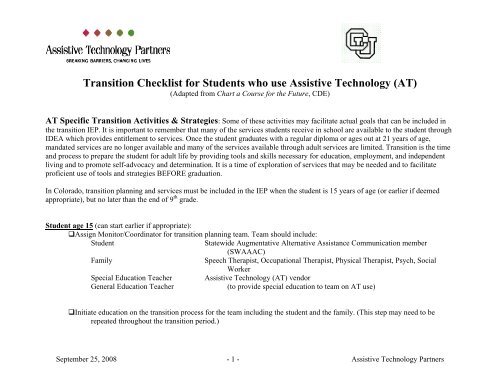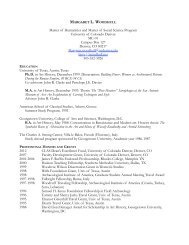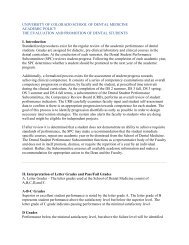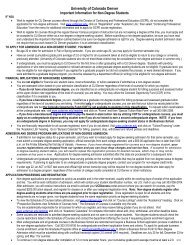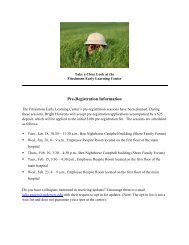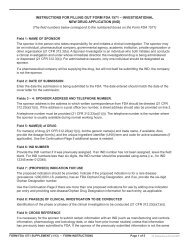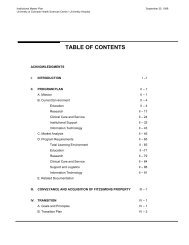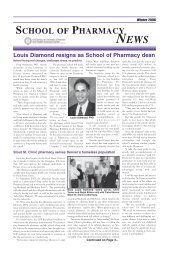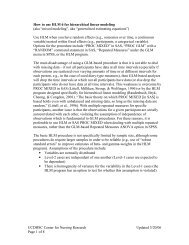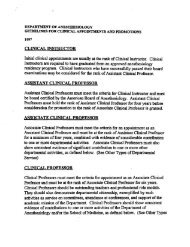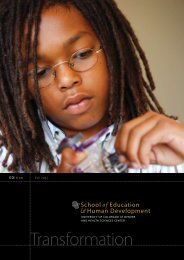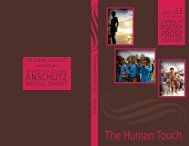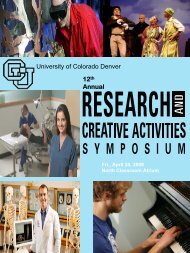Transition Checklist for Students who use AT - University of ...
Transition Checklist for Students who use AT - University of ...
Transition Checklist for Students who use AT - University of ...
Create successful ePaper yourself
Turn your PDF publications into a flip-book with our unique Google optimized e-Paper software.
<strong>Transition</strong> <strong>Checklist</strong> <strong>for</strong> <strong>Students</strong> <strong>who</strong> <strong>use</strong> Assistive Technology (<strong>AT</strong>)<br />
(Adapted from Chart a Course <strong>for</strong> the Future, CDE)<br />
<strong>AT</strong> Specific <strong>Transition</strong> Activities & Strategies: Some <strong>of</strong> these activities may facilitate actual goals that can be included in<br />
the transition IEP. It is important to remember that many <strong>of</strong> the services students receive in school are available to the student through<br />
IDEA which provides entitlement to services. Once the student graduates with a regular diploma or ages out at 21 years <strong>of</strong> age,<br />
mandated services are no longer available and many <strong>of</strong> the services available through adult services are limited. <strong>Transition</strong> is the time<br />
and process to prepare the student <strong>for</strong> adult life by providing tools and skills necessary <strong>for</strong> education, employment, and independent<br />
living and to promote self-advocacy and determination. It is a time <strong>of</strong> exploration <strong>of</strong> services that may be needed and to facilitate<br />
pr<strong>of</strong>icient <strong>use</strong> <strong>of</strong> tools and strategies BEFORE graduation.<br />
In Colorado, transition planning and services must be included in the IEP when the student is 15 years <strong>of</strong> age (or earlier if deemed<br />
appropriate), but no later than the end <strong>of</strong> 9 th grade.<br />
Student age 15 (can start earlier if appropriate):<br />
Assign Monitor/Coordinator <strong>for</strong> transition planning team. Team should include:<br />
Student Statewide Augmentative Alternative Assistance Communication member<br />
(SWAAAC)<br />
Family Speech Therapist, Occupational Therapist, Physical Therapist, Psych, Social<br />
Worker<br />
Special Education Teacher Assistive Technology (<strong>AT</strong>) vendor<br />
General Education Teacher (to provide special education to team on <strong>AT</strong> <strong>use</strong>)<br />
Initiate education on the transition process <strong>for</strong> the team including the student and the family. (This step may need to be<br />
repeated throughout the transition period.)<br />
September 25, 2008 - 1 - Assistive Technology Partners
Include measurable post-school goals in the IEP. The student’s interests and aptitudes should be a central to consider:<br />
a) Postsecondary education and training options,<br />
b) vocational interests and abilities leading to career goals<br />
c) independent living needs and options<br />
d) related support services (driving, using public transportation, OT/PT, etc.)<br />
Initiate development <strong>of</strong> a portfolio that the student keeps to include and organize important documentation such as:<br />
Birth Certificate<br />
Student’s social security card<br />
Colorado ID (from Drivers License Bureau)<br />
IEP history<br />
Credit and Academic Skills Audit Worksheet<br />
Begin or continue <strong>AT</strong>-related assessment processes with appropriate disciplines:<br />
a) Create a Student-centered pr<strong>of</strong>ile based on student’s input. Can <strong>use</strong> tools such as Full Life Ahead: A Workbook and<br />
Guide to Adult Life <strong>for</strong> <strong>Students</strong> & families <strong>of</strong> <strong>Students</strong> with Disabilities, by Judy Barclay & Jan Cobb, or<br />
Teaching Self-Determination to <strong>Students</strong> With Disabilities: Basic Skills <strong>for</strong> Successful <strong>Transition</strong>, by Michael L.<br />
Wehmeyer, Martin Agran, and Carolyn Hughes.<br />
b) Identify <strong>AT</strong> needs. This should include <strong>AT</strong> device, switches if needed, mounts, appropriate positioning and mobility<br />
devices (wheelchairs), ergonomic furniture, s<strong>of</strong>tware, etc.<br />
c) Explore learning styles in relation to <strong>AT</strong> and facilitate appropriate accommodations, such as preferential seating, FM<br />
system in the classroom, prepared notes prior to classroom lesson, alternative curriculum <strong>for</strong> computer access,<br />
low vision, etc.<br />
Helpful Links: http://www.peakparent.org/resourceMaterials.asp<br />
http://das.kucrl.org/iam/Ensuring.html<br />
September 25, 2008 - 2 - Assistive Technology Partners
Explore support systems <strong>for</strong> <strong>AT</strong>. Identify staff that is responsible <strong>for</strong> daytime support, programming, and maintenance<br />
<strong>of</strong> <strong>AT</strong>.<br />
Continue self-advocacy training with student and family with emphasis on:<br />
a) <strong>AT</strong> programming as needs change, regular maintenance (i.e., battery charging,<br />
battery replacement, cleaning, etc),<br />
b) troubleshooting with malfunctioning <strong>AT</strong> equipment and,<br />
c) identification <strong>of</strong> <strong>who</strong> to call <strong>for</strong> repairs.<br />
Helpful Hint: Call the vendor <strong>of</strong> the <strong>AT</strong> equipment. Often, they are willing to do 1:1 training or address problems over<br />
the phone. Also look at specific <strong>AT</strong> company websites <strong>for</strong> online trainings, webinars, archived .pdf documents that<br />
might answer your questions. You may even consider creating a “how to” video <strong>of</strong> your particular student with his <strong>AT</strong><br />
device <strong>for</strong> training other staff.<br />
Begin to have student access public transportation or explore other transportation options (i.e., driving, Access-A-Ride, fixed<br />
route with RTD, etc.) with <strong>use</strong> <strong>of</strong> <strong>AT</strong>. Include goals <strong>of</strong> arriving at destination ‘on time’.<br />
Helpful Links: http://www.specialtransit.org/get_started.htm#p4<br />
http://www.revenue.state.co.us/mv_dir/<strong>for</strong>mspdf/2816.pdf<br />
Provide career awareness with special emphasis on career paths that are relevant to students interests and capabilities.<br />
a) Include observations <strong>of</strong> successful <strong>AT</strong> <strong>use</strong>rs in the workplace<br />
b) Facilitate job shadows<br />
c) Explore summer job or volunteer opportunities.<br />
September 25, 2008 - 3 - Assistive Technology Partners
Educate student and family on civil rights specific to accessibility and services that may be available to them in the<br />
community. Agencies to contact might include Division <strong>of</strong> Vocational Rehabilitation (DVR), Community Centered<br />
Board (CCB), The Legal Center <strong>for</strong> People with Disabilities and Older People, Center <strong>for</strong> Personal Assistant Services,<br />
etc.<br />
Helpful Links: http://www.pascenter.org/home/index.php<br />
http://www.thelegalcenter.org/<br />
http://www.cdhs.state.co.us/dvr/<br />
http://www.cdhs.state.co.us/ddd/CCB_Main.htm<br />
Initiate application to adult service agencies with lengthy waiting lists such as Community Centered Boards (CCB) at age<br />
14, and day programming if student will need such services. The Office <strong>of</strong> Adult, disability, and Rehabilitation<br />
Services has a helpful website. See link below.<br />
Helpful Links: http://www.cdhs.state.co.us/adrs/In<strong>for</strong>mationDDD.htm<br />
During Junior year or 2 years be<strong>for</strong>e leaving school:<br />
Review <strong>AT</strong> equipment annually. Assess if still appropriate <strong>for</strong> developing academic skills and access to curriculum (The<br />
SWAAAC team member and/or SLP should be involved with this). For example:<br />
a) Does the student need different switches, mounting, or wheelchair positioning due to any physical, cognitive and/or<br />
emotional changes?<br />
b) Has vision changed and is the current technology still adequate <strong>for</strong> access to curriculum?<br />
c) Has the student’s adaptive skills increased? For example, has the student learned to read Braille and will a<br />
refreshable Braille display increase access to computer? Or speech recognition s<strong>of</strong>tware?<br />
d) Does the <strong>AT</strong> device allow vocational <strong>use</strong> or has <strong>use</strong> been primarily foc<strong>use</strong>d on curriculum? If so, can programming<br />
be expanded <strong>for</strong> broader <strong>use</strong> is more than one setting?<br />
September 25, 2008 - 4 - Assistive Technology Partners
Continue with the student-centered tool that provide worksheets and questions.<br />
Continue Job/Career investigation. This should include site visits, on the job training, internships, and mentoring by<br />
graduates <strong>who</strong> successfully <strong>use</strong> <strong>AT</strong> in the workplace.<br />
Helpful Links: http://calendar.politicswest.com/denver-co/events/show/84462951-colorado-celebrates-2008-disabilitymentoring-day-connecting-youth-to-careers<br />
http://www.enableamerica.org/whatwedo.asp<br />
Initiate application <strong>for</strong> driver’s license or bus pass. Student should be attaining maximum independence in the most<br />
appropriate mode <strong>of</strong> community mobility. This might look like:<br />
a) knowing the bus schedule <strong>for</strong> a fixed route,<br />
b) planning and calling <strong>for</strong> Access-A-Ride or a ride from other source,<br />
c) driving safely to and from destination.<br />
Involve Vocational Rehab counselor in planning <strong>for</strong> seamless transition after graduation. This should be done during the last<br />
year <strong>of</strong> school, at the very latest but can be initiated earlier.<br />
Student to write a resume, complete an application to post-secondary education institution, collect letters <strong>of</strong><br />
recommendation, write cover letters, write essays if needed, and fill out applications <strong>for</strong> jobs.<br />
Explore support systems in chosen setting <strong>for</strong> future <strong>AT</strong> needs. For example, in vocational or educational setting, the<br />
student should have a name <strong>of</strong> a staff or faculty member <strong>who</strong>m they can call <strong>for</strong> support with <strong>AT</strong> needs. This should be<br />
part <strong>of</strong> the self-sufficiency/advocacy/determination training that should be happening throughout the transition process.<br />
Helpful Links: http://www.colorado.edu/disabilityservices/fsfaq.html<br />
http://teaching.berkeley.edu/bgd/disabilities.html<br />
September 25, 2008 - 5 - Assistive Technology Partners
Establish a list <strong>of</strong> <strong>AT</strong> needs prior to graduation. The student should be able to advocate <strong>for</strong> all the services needed.<br />
A DVR counselor will assist with getting the student established in the new setting both vocational and educational.<br />
Collect necessary documentation <strong>for</strong> any accommodations needed in the next setting. These should be placed in the student’s<br />
portfolio with transcripts, letter <strong>of</strong> recommendation, cover letters and resume and included in the student’s Summary <strong>of</strong><br />
Per<strong>for</strong>mance.<br />
Take appropriate tests with necessary accommodations.<br />
Helpful Links: http://www.collegeboard.com/ssd/student/accom.html<br />
Facilitate mock interviews, <strong>use</strong> <strong>of</strong> adaptive telecommunications to make appointments or to seek assistance, money<br />
management training with specific disability in mind (i.e., low vision, motor, cognitive or hearing disability).<br />
Apply <strong>for</strong> financial support with as much student participation as possible. This might include Supplemental Security<br />
Income (SSI), Independent Living Services, Vocational Rehabilitation (DVR), and Personal Assistant Services. All<br />
arrangements should include specific accommodations needed <strong>for</strong> <strong>AT</strong> <strong>use</strong>.<br />
September 25, 2008 - 6 - Assistive Technology Partners


